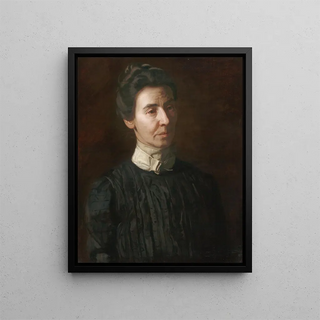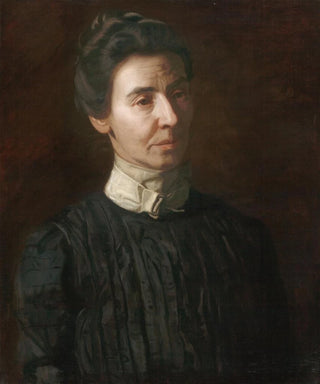Art print | Portrait of Mary Adeline Williams - Thomas Eakins Source: Reproduction | Portrait de Mary Adeline Williams - Thomas Eakins


View from behind

Frame (optional)
Portrait of Mary Adeline Williams - Thomas Eakins – Captivating Introduction
The "Portrait of Mary Adeline Williams" by Thomas Eakins is a work that transcends mere representation to delve into the depths of the human soul. Created at the end of the 19th century, this painting showcases Eakins's technical skill and artistic sensitivity, a master of American realistic painting. In this work, Eakins does not merely capture the physical appearance of his model but also explores the emotional nuances emanating from her gaze. The psychological depth and delicacy of Mary Adeline Williams's features make this portrait a true masterpiece, an open window into a particular era and personality.
Style and uniqueness of the work
Thomas Eakins's style is characterized by striking realism, where every detail is carefully observed and rendered. In the "Portrait of Mary Adeline Williams," light plays a crucial role, subtly illuminating the sitter's face while creating delicate shadows that add an almost sculptural dimension to her appearance. Eakins employs a nuanced color palette that enhances the softness of Mary's features while revealing the complexity of her character. This portrait stands out for its psychological approach, where the model's gaze seems to capture a moment of introspection, inviting the viewer to reflect on her thoughts and emotions. The composition, both simple and elegant, reinforces this intimacy, making the work a poignant testament to Mary Adeline Williams's personality.
The artist and his influence
Thomas Eakins, born in 1844 in Philadelphia, is considered one of the greatest American painters of his time. His academic training, combined with his interest in science and medicine, allowed him to develop a unique approach to human representation. Eakins was a pioneer in using photography to study movement and posture, integrating this knowledge into his painting. His influence is felt not only in the art world but also in how he redefined the portrait as a genre. Emphasizing psychology and emotional truth, he opened the

Matte finish

View from behind

Frame (optional)
Portrait of Mary Adeline Williams - Thomas Eakins – Captivating Introduction
The "Portrait of Mary Adeline Williams" by Thomas Eakins is a work that transcends mere representation to delve into the depths of the human soul. Created at the end of the 19th century, this painting showcases Eakins's technical skill and artistic sensitivity, a master of American realistic painting. In this work, Eakins does not merely capture the physical appearance of his model but also explores the emotional nuances emanating from her gaze. The psychological depth and delicacy of Mary Adeline Williams's features make this portrait a true masterpiece, an open window into a particular era and personality.
Style and uniqueness of the work
Thomas Eakins's style is characterized by striking realism, where every detail is carefully observed and rendered. In the "Portrait of Mary Adeline Williams," light plays a crucial role, subtly illuminating the sitter's face while creating delicate shadows that add an almost sculptural dimension to her appearance. Eakins employs a nuanced color palette that enhances the softness of Mary's features while revealing the complexity of her character. This portrait stands out for its psychological approach, where the model's gaze seems to capture a moment of introspection, inviting the viewer to reflect on her thoughts and emotions. The composition, both simple and elegant, reinforces this intimacy, making the work a poignant testament to Mary Adeline Williams's personality.
The artist and his influence
Thomas Eakins, born in 1844 in Philadelphia, is considered one of the greatest American painters of his time. His academic training, combined with his interest in science and medicine, allowed him to develop a unique approach to human representation. Eakins was a pioneer in using photography to study movement and posture, integrating this knowledge into his painting. His influence is felt not only in the art world but also in how he redefined the portrait as a genre. Emphasizing psychology and emotional truth, he opened the






